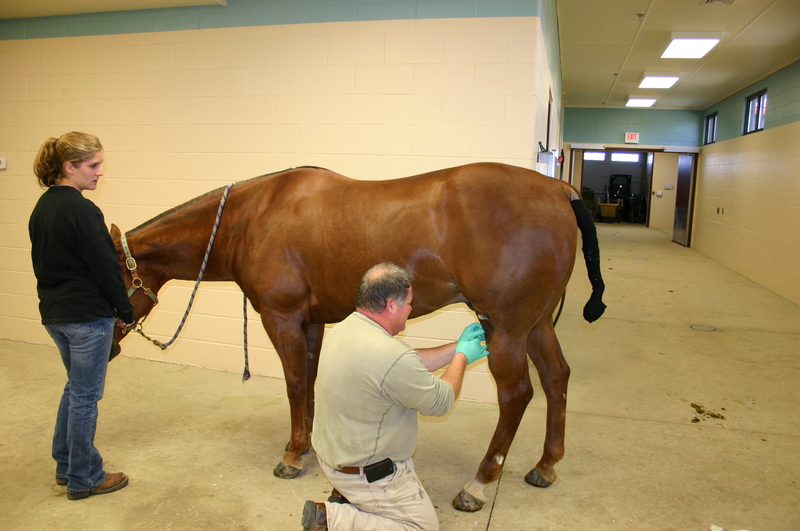 We hear a lot about it. We have had them performed on our own horses. But do you actually understand the process of joint injection, and the risks and benefits of performing joint injections?
We hear a lot about it. We have had them performed on our own horses. But do you actually understand the process of joint injection, and the risks and benefits of performing joint injections?
The technical term for injecting a joint space in a horse is arthrocentesis. Arthrocentesis means introducing a needle into a joint space, either to remove fluid for diagnostic purposes, or to introduce a fluid or medication into the joint space for treatment. There are many indications for arthrocentesis besides just “injecting the joint” therapeutically.
If a veterinarian suspects a joint space may have been compromised with a wound, the vet may attempt to pressurize the joint space with saline to see if the saline leaks out the wound. The vet may also attempt to draw joint fluid from the joint for cytology to look for abnormal amounts of cells or protein levels that indicate infection or inflammation. Also, suspected infected joint fluid can be sent to a lab to have a culture and sensitivity performed to establish the type of infection, and the appropriate antibiotics or antifungals to use to treat it.
Infected joints are often flushed through and through with saline. This is a great example of one of my favorite sayings – dilution is the solution to pollution. The vet will put two needles into the joint space, and pressurize saline into one needle, and it will flow out the other. If a joint space is infected, by flushing sterile saline through the joint space, we can rid the joint of not only bacteria but also inflammatory elements, like fibrin and proteins, allowing faster healing of the infection. Infected joints also will often have antibiotics instilled into them as a therapeutic treatment for infection.
A vet may also inject local anesthetics into a joint space to attempt to localize the source of lameness. For instance, if a vet suspects a coffin joint may be the source of infection, they can inject Marcaine or Lidocaine into the joint space, allow it some time to take effect, and then watch the horse move to see if that eliminates the lameness. The use of local anesthetics is perhaps one of the most important diagnostic tools we have in the management of lameness in horses along with the physical exam – because horses can’t tell us where they hurt, if we can eliminate the source of their pain with the local anesthetic, we can localize the area to target our further advanced diagnostics, like radiographs, ultrasound, or MRI.
 But perhaps the most frequent use of joint injection is for therapeutic lameness treatment – the introduction of medications into the joint space to reduce inflammation and pain. There are many different products used, such as hyaluronic acid, long and short acting steroids or polysulfated glycosaminoglycans. Most veterinarians have their preference as to which products they like to use, which may also differ depending on the joint space. For example, a vet may choose to use a small dose of a long-acting steroid for a lower hock injection, if the goal is to reduce pain and encourage fusion of the joint. However, that result would be detrimental to a larger high-motion joint space like the stifle, where they may choose to use a hyaluronic acid product instead.
But perhaps the most frequent use of joint injection is for therapeutic lameness treatment – the introduction of medications into the joint space to reduce inflammation and pain. There are many different products used, such as hyaluronic acid, long and short acting steroids or polysulfated glycosaminoglycans. Most veterinarians have their preference as to which products they like to use, which may also differ depending on the joint space. For example, a vet may choose to use a small dose of a long-acting steroid for a lower hock injection, if the goal is to reduce pain and encourage fusion of the joint. However, that result would be detrimental to a larger high-motion joint space like the stifle, where they may choose to use a hyaluronic acid product instead.
It is important to recognize that joint injection does not come without risk. Every time a needle is introduced into a joint space, there is a chance of infection. Every single time. This is a function of many things, but boils down to the introduction of bacteria into the joint when the needle is inserted through the skin.
Veterinarians have protocols in place to reduce the incidence of infection, but the reality is that no matter how experienced or how frequently a veterinarian performs injections, there is always that risk. A wise veterinarian once told me there are two kinds of veterinarians who inject joints – those who have already had a joint infection happen, and those who will have one happen in the future. Proper preventative procedures may include things like use of single-dose vials of medications, use of new needles and gloves when injecting the space, and the addition of antibiotics to the injectable medications to attempt to prevent infection.
Joint infections can be career ending and potentially life threatening, so it is important to take these steps to prevent infection. It is also important to be able to quickly recognize the signs of joint infection, and to contact your vet immediately to institute treatment – the sooner that aggressive treatment of joint infection is started, the better the outcomes. The first sign most people notice is the sudden onset of a severe lameness in the leg that was injected. There may or may not be swelling or inflammation of the joint space just yet, so it is very important to call your vet immediately, and on emergency if it is after hours or the weekend, if you see lameness within the first couple days after joint injection.



You must be logged in to post a comment Login